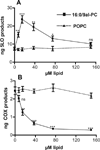Phospholipid Ozonation Products Activate the 5-Lipoxygenase Pathway in Macrophages
- PMID: 27448436
- PMCID: PMC5029860
- DOI: 10.1021/acs.chemrestox.6b00193
Phospholipid Ozonation Products Activate the 5-Lipoxygenase Pathway in Macrophages
Abstract
Ozone is a highly reactive environmental toxicant that can react with the double bonds of lipids in pulmonary surfactant. This study was undertaken to investigate the proinflammatory properties of the major lipid-ozone product in pulmonary surfactant, 1-palmitoyl-2-(9'-oxo-nonanoyl)-glycerophosphocholine (16:0/9al-PC), with respect to eicosanoid production. A dose-dependent increase in the formation of 5-lipoxygenase (5-LO) products was observed in murine resident peritoneal macrophages (RPM) and alveolar macrophages (AM) upon treatment with 16:0/9al-PC. In contrast, the production of cyclooxygenase (COX) derived eicosanoids did not change from basal levels in the presence of 16:0/9al-PC. When 16:0/9al-PC and the TLR2 ligand, zymosan, were added to RPM or AM, an enhancement of 5-LO product formation along with a concomitant decrease in COX product formation was observed. Neither intracellular calcium levels nor arachidonic acid release was influenced by the addition of 16:0/9al-PC to RPM. Results from mitogen-activated protein kinase (MAPK) inhibitor studies and direct measurement of phosphorylation of MAPKs revealed that 16:0/9al-PC activates the p38 MAPK pathway in RPM, which results in the activation of 5-LO. Our results indicate that 16:0/9al-PC has a profound effect on the eicosanoid pathway, which may have implications in inflammatory pulmonary disease states where eicosanoids have been shown to play a role.
Figures




References
-
- Pryor WA. How far does ozone penetrate into the pulmonary air/tissue boundary before it reacts? Free Radic. Biol. Med. 1992;12:83–88. - PubMed
-
- Pryor WA, Squadrito GL, Friedman M. The cascade mechanism to explain ozone toxicity: the role of lipid ozonation products. Free Radic. Biol. Med. 1995;19:935–941. - PubMed
-
- Lewis JF, Jobe AH. Surfactant and the adult respiratory distress syndrome. Am. Rev. Respir. Dis. 1993;147:218–233. - PubMed
-
- Uhlson C, Harrison K, Allen CB, Ahmad S, White CW, Murphy RC. Oxidized phospholipids derived from ozone-treated lung surfactant extract reduce macrophage and epithelial cell viability. Chem. Res. Toxicol. 2002;15:896–906. - PubMed
Publication types
MeSH terms
Substances
Grants and funding
LinkOut - more resources
Full Text Sources
Other Literature Sources
Medical

